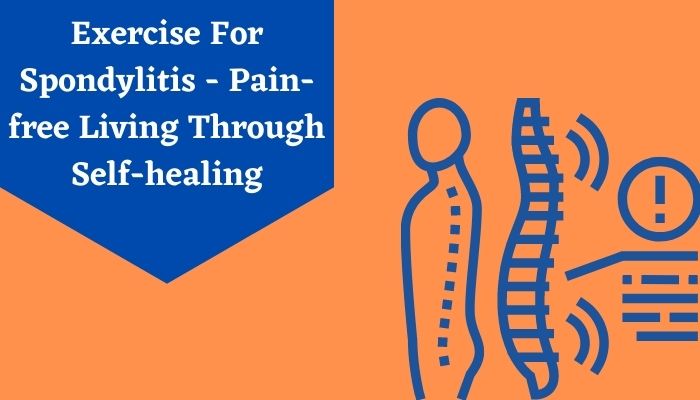Cervical spondylitis or cervical osteoarthritis is a condition that deteriorates your vertebrae, discs, and ligaments in the cervical spine. Under this condition, the edges of the vertebrae often develop bone limbs called osteophytes. For a prolonged time, your disc gradually gets thinner. Exercise for Spondylitis is one of the best ways to experience relief.
Causes Of Cervical Spondylitis
- Poor posture over a longer period may be responsible for cervical spondylitis. These days, most people go for desk jobs where they need to sit a long time in front of computers.
- Nutritional deficiencies may also play a big factor in cervical spondylitis
- Aging is also another reason
Symptoms Of Spondylitis
Prime symptoms are weakness and pain. In some severe cases, the disc can press on a nerve that can lead to a loss of consciousness and mobility issues.Treatment for Spondylitis
Muscle relaxants, steroid injections, and physical therapy are generally recommended by doctors to treat the symptoms of cervical spondylitis. Muscle relaxants are beneficial if the person experiences neck spasms. A neck spasm is a condition where your neck muscles tighten suddenly. Popular muscle relaxants are cyclobenzaprine.Antidepressants, like amitriptyline, are useful in relieving persistent pain that has not responded to other treatments. Gabapentin is a popular option.
An injection of steroids is effective and will help you to deal with very severe pain.
Examples of steroid injections include:
- a trigger-point injection that can be administered at a doctor’s chamber
- a facet joint injection
- a cervical epidural steroid injection (ESI), performed under fluoroscopy along with the help of an x-ray
- Continuous neck pain that radiates down the arm
- A loss of sensation
- Muscle weakness/numbness
- A loss of bowel or bladder function
Let’s take a look at some cervical spondylosis exercises.
1. Neck Stretch
- First, keep your body in a straight position
- Now, stretch the throat by pushing your chin forward
- Gently tense the neck muscles
- Hold this position for 5 seconds
- Now, put your head back to its center position
- Push your head back with the chin held high, and hold for 5 seconds
- Repeat this posture 5 times to ease your pain.
2. Neck Tilt
- Try to touch your chest with your chin by putting your head forward
- Delicately tense the neck muscles
- Hold this position for 5 seconds
- Return the head to a neutral position.
- Repeat this position 5 times a day
3. Neck Tilt (side-to-side)
- Now, put your head down towards either shoulder, leading with the ear.
- Gently tense the neck muscles
- Hold this position for 5 seconds.
- Keep your head back to the center and repeat on another side
- Carry out this posture 5 times a day
4. Neck Turn
- Turn your head to one side as long as you are comfortable, keeping your chin at a level height
- Gently tense your neck muscles for 5 seconds
- Return the head to a central position.
- Repeat the exercise for the opposite side
- Carry out this exercise 5 times each day.
5. Arm Lifts
- Stand in a comfortable position and extend your arms straight out to the front with palms
- Now, raise the arms and bring them adjacent to your ears, while inhaling deeply.
- Move gradually so that you don’t feel any pain.
- Repeat this posture 8 times a day
6. Yoga
Yoga helps many people to combat their pain. Many stretching and relaxation yoga exercises will give you relief from the pain of cervical spondylosis. Here are some asanas that you can incorporate into your spondylitis treatment exercises.Gomukhasana
- First, sit down on folded knees, with one slightly higher than the other.
- Now, keep your spine straight, place one hand on the shoulder blade of the same side.
- By using another hand, reach around the back and up to the other hand.
- Try to touch the shoulder blade with your fingers.
- Hold this position for 10 seconds and then switch sides and repeat
- Stand straight by using your feet together
- Elevate your arms over your head while inhaling deeply
- Interlock your fingers so that your palms are extended upward
- Stretch the entire body upwards
- While exhaling, lower your hands till they rest on the top of your head
- Repeat this position 5 times a day
Home Remedies for Spondylitis
Apart from exercises, people can take some steps to relieve symptoms if cervical spondylosis becomes excruciating for them. You may use some over-the-counter (OTC) medications to minimize your pain.These medications could be
- Nonsteroidal anti-inflammatory drugs (NSAIDs): Popular available brands in the market are ibuprofen or naproxen
- Acetaminophens, such as Tylenol
Other options could be
Regular Exercise: This will boost your recovery time from sessions of pain.
A Heated Pad or Cold Pack: When neck muscles become sore, this could give relief from the pain. You can easily purchase a heated pad or cold pack from online or offline stores.
A Soft Neck Brace: If you are looking for short-term relief, then you must wear these braces for a certain period. Don’t use them for longer periods as they make your muscles weaker.



